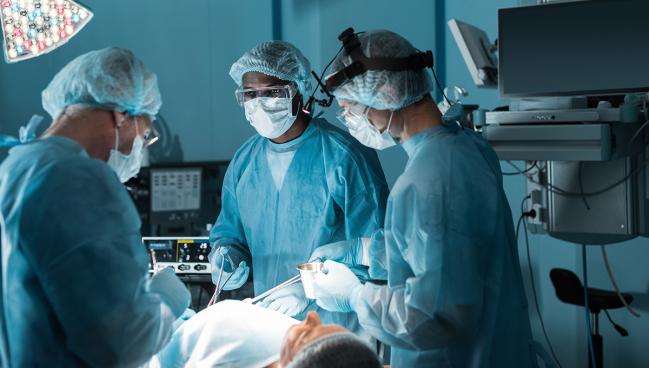New Guidelines for CV Care in Patients Undergoing Noncardiac Surgery
Stepwise, perioperative cardiac screening can help clinicians decide when to proceed with surgery or pause for more testing.

New guidelines from the American College of Cardiology and the American Heart Association (ACC/AHA), in collaboration with several other groups, are now available for the perioperative evaluation and management of cardiovascular risk in patients undergoing noncardiac surgery.
Updated from 2014, the guidelines tackle everything from preoperative evaluation to postoperative care, with particular attention paid to risk assessment, evaluation of functional status, appropriate use of cardiovascular testing and screening, and management of various cardiovascular conditions and risks, the ACC/AHA writing committee states in the document, published online Tuesday in Circulation.
“Also addressed are evidence-based management strategies, including pharmacological therapies, perioperative monitoring, and devices, for CVD and associated medical conditions,” according to writing committee chair Annemarie Thompson, MD, MBA (Duke University School of Medicine, Durham, NC), and colleagues.
Thompson, to TCTMD, emphasized that the guidelines were drafted by many experts in cardiovascular care who are also hands-on clinicians who take care of patients daily. The recommendations are primarily focused on elevated-risk noncardiac operations, such as high-risk procedures, including neurosurgery, thoracic surgery, and vascular surgery, and moderate-risk procedures, among them orthopedic, breast, and urologic surgery. There is little to be gained by extensive preoperative testing in patients scheduled for low-risk procedures, such as cataract surgery, dental procedures, or skin biopsies, say the experts.
However, Thompson cautioned that a high-risk patient can still be at risk for cardiovascular complications while undergoing a low-risk procedure.
“An example of this would be a sedated gastroenterological procedure, perhaps even in an outpatient setting, that’s considered a fairly low-risk procedure,” she said. “If they have high-risk cardiovascular features, they are at increased risk for cardiovascular complications. With that situation, it’s important that all clinicians—not just the anesthesiologist or the cardiologist, but also the proceduralist—know that there are patients going for what might be, in other patients, a fairly routine low-risk procedure but can be an elevated-risk procedure for a patient with preexisting cardiovascular disease.”
Stepwise Approach to Screening
In the US, there are nearly 35 million inpatient and ambulatory surgeries performed each year, and cardiovascular risk factors and disease are common in these patients. One study showed that roughly 45% of those 45 years and older undergoing noncardiac surgery have cardiovascular risk factors while nearly one-quarter of surgical patients have atherosclerotic CVD. Perioperative cardiovascular complications remain an important cause of morbidity and mortality in noncardiac surgery.
The new guideline, like others prior, proposes a stepwise approach to perioperative cardiac assessment to help clinicians decide if a surgery should go forward or be put on hold so the patient can undergo further testing. Screening and treatment of surgical patients should follow the same line as nonsurgical patients, although clinicians should be careful to avoid delays to surgery, if possible.
In the 2024 cardiac assessment algorithm, clinicians are advised to estimate perioperative risk using a validated risk-prediction calculator (class 2a, level of evidence B), of which there are several, including the Revised Cardiac Risk Index (RCRI) and the American College of Surgeons National Surgical Quality Improvement Program (NSQIP) perioperative MI and cardiac arrest risk calculator.
However, given that several cardiovascular conditions can increase the risk of complications, the writing committee includes risk modifiers as part of the evaluation. Modifiers of cardiovascular risk include the presence of severe valvular heart disease, severe pulmonary hypertension, elevated-risk congenital heart disease, prior coronary stent/CABG surgery, recent stroke, pacemaker/implantable cardioverter-defibrillator, and frailty.
These conditions, said Thompson, “confer additional risk that isn’t represented by the risk calculators.”
In prior guidelines, there was a large focus on identifying, managing, and treating patients with ischemic heart disease scheduled for noncardiac surgery. While that is appropriate, Thompson said, the impact of these other conditions on surgical outcomes may have gone unappreciated.
“So, that really led the committee to include some of [the risk modifiers] just as a caution to clinicians,” she said. “Use the risk calculator, but also look to see if the patient has any of these other risk modifiers. If they do, make sure you have a plan. Make sure you've thought about this before they go on to surgery. That doesn't mean you need to do things in terms of testing necessarily, but you do have to have a plan for managing these conditions.”
In addition to risk modifiers, the risk-assessment algorithm newly incorporates preoperative biomarker assessment (NT-proBNP and cardiac troponin) in select patients.
“This is an additional way to use our tests wisely, [a way] not to overtest and not to overtreat,” said Thompson. “It gives us another step, another way to do a biochemical measurement of the patient to determine if they’re at elevated risk of a negative cardiovascular outcome or not before we go to more invasive testing.”
Other Recommendations
In general, stress testing “should be performed judiciously,” according to the guidelines, especially in lower-risk patients, and should be done only when it would be appropriate independent of the planned noncardiac surgery. The guidelines now include cardiac CT angiography as a screening tool, specifically for those with poor or unknown functional capacity and elevated risk for perioperative events (class 2b, level of evidence B).
There is also direction on antiplatelet therapy and timing of noncardiac surgery in patients with CAD. For ACS patients who have received a DES, surgery should be delayed for 12 months or more, if possible, to minimize the risk of MACE associated with interrupting antiplatelet therapy (class 1, level of evidence B). Chronic coronary disease patients who were stented with DES should delay surgery at least 6 months (class 2a, level of evidence B). However, if surgery is time sensitive, but not emergent or urgent, it can be considered at 3 months or later (class 2b, level of evidence B).
Perioperative bridging of oral anticoagulation should only be done in patients at the highest thrombotic risk and is not recommended in the majority of surgeries. For those with diabetes, heart failure, or obesity taking SGLT2 inhibitors, the drug should be stopped at least 3 to 4 days before surgery to reduce the risk of perioperative ketoacidosis. Additionally, atrial fibrillation diagnosed after noncardiac surgery should be followed closely given the risks of stroke.
Importantly, the guideline, like many others, emphasizes a team-based approach to care.
“Patients come for noncardiac surgery, and it does take a team approach to really thoughtfully plan for the safest outcome,” said Thompson. “We just don't want to extend life. We also want to restore or maintain function, and that’s what this guideline really looks at.”
Michael O’Riordan is the Managing Editor for TCTMD. He completed his undergraduate degrees at Queen’s University in Kingston, ON, and…
Read Full BioSources
Thompson A, Fleischmann KE, Smilowitz NR, et al. 2024 AHA/ACC/ACS/ASNC/HRS/SCA/SCCT/SCMR/SVM guideline for perioperative cardiovascular management for noncardiac surgery: a report of the American College of Cardiology/American Heart Association joint committee on clinical practice guidelines. Circulation. 2024;Epub ahead of print.
Disclosures
- Thompson reports no relevant conflicts of interest.





Comments